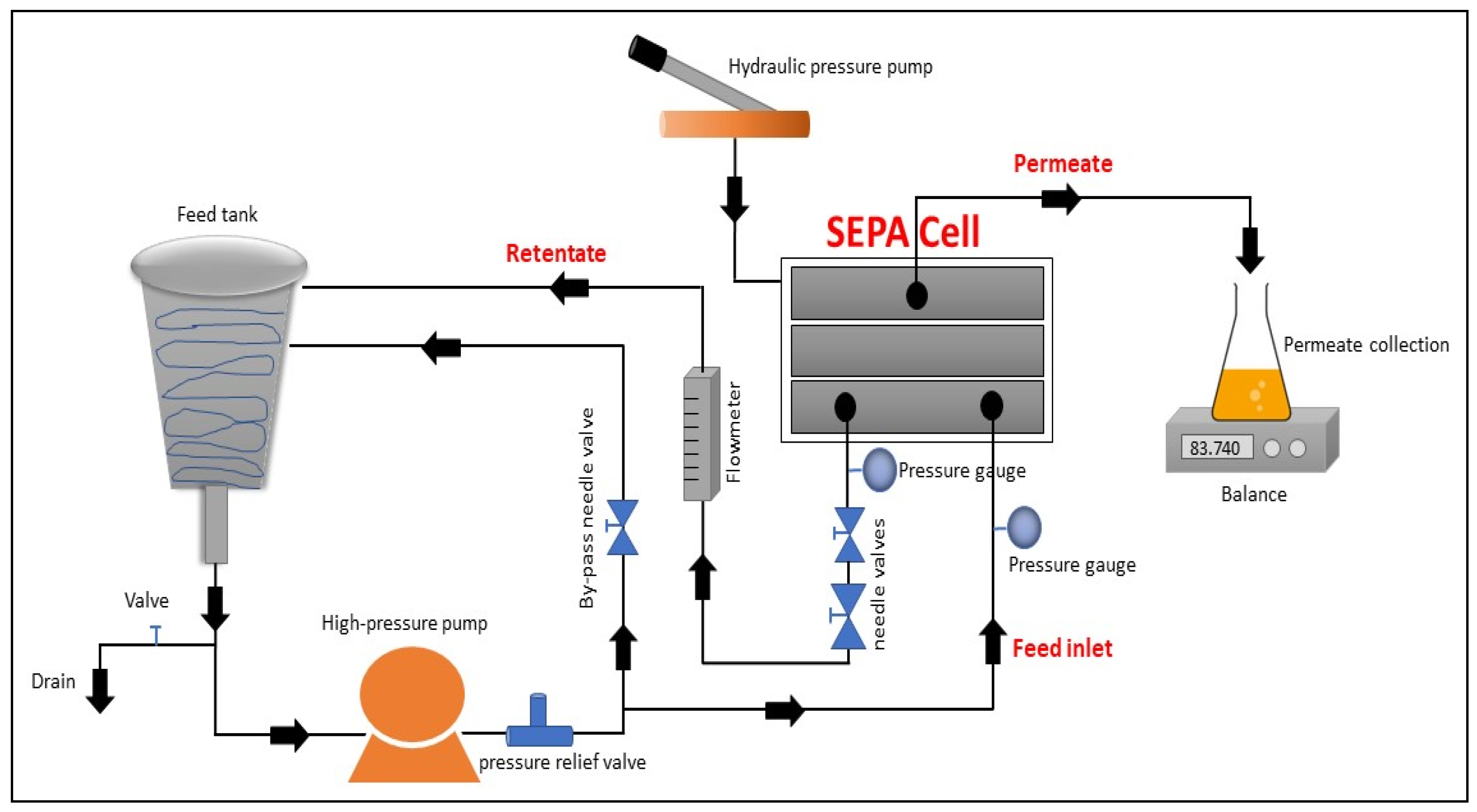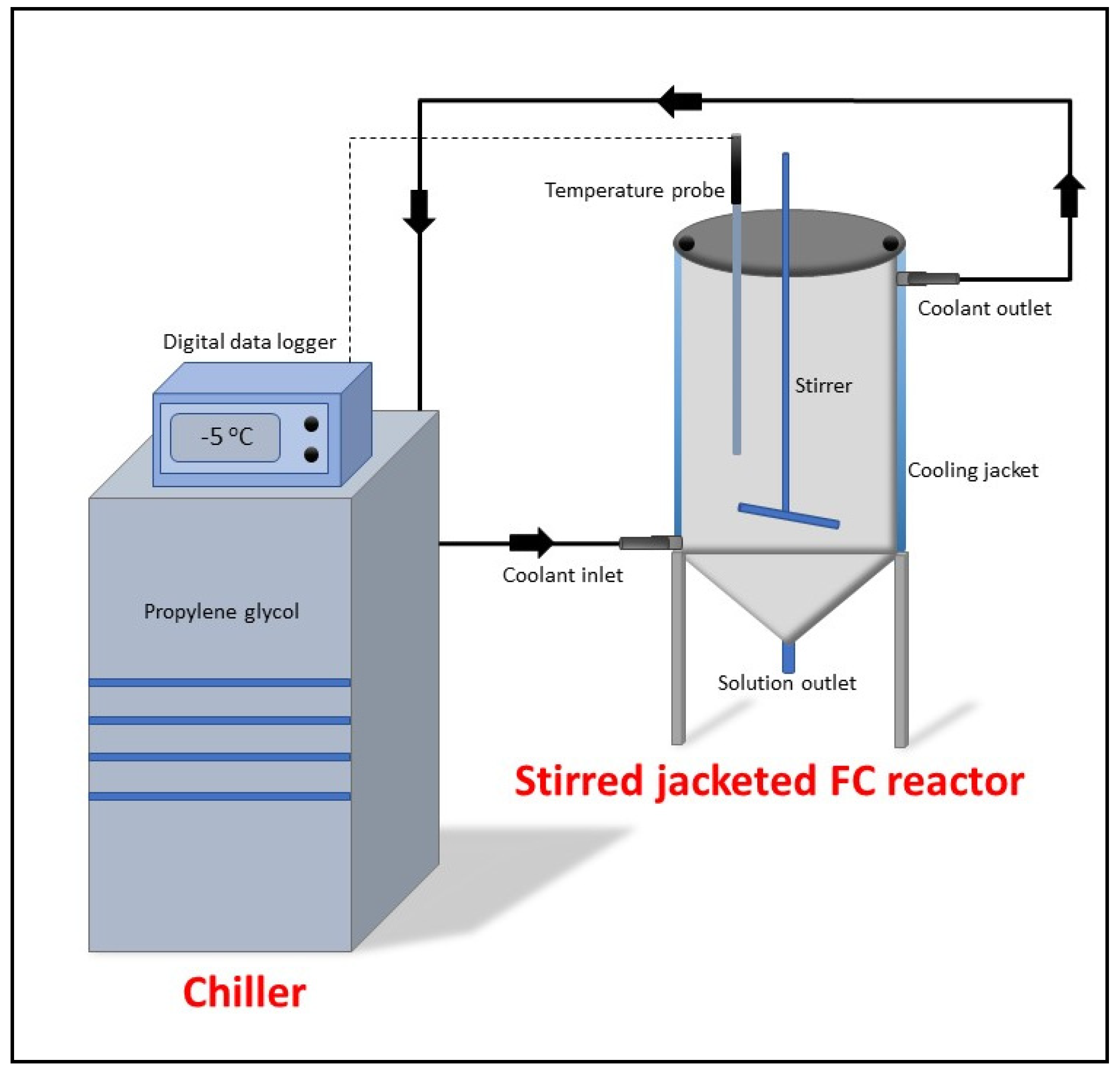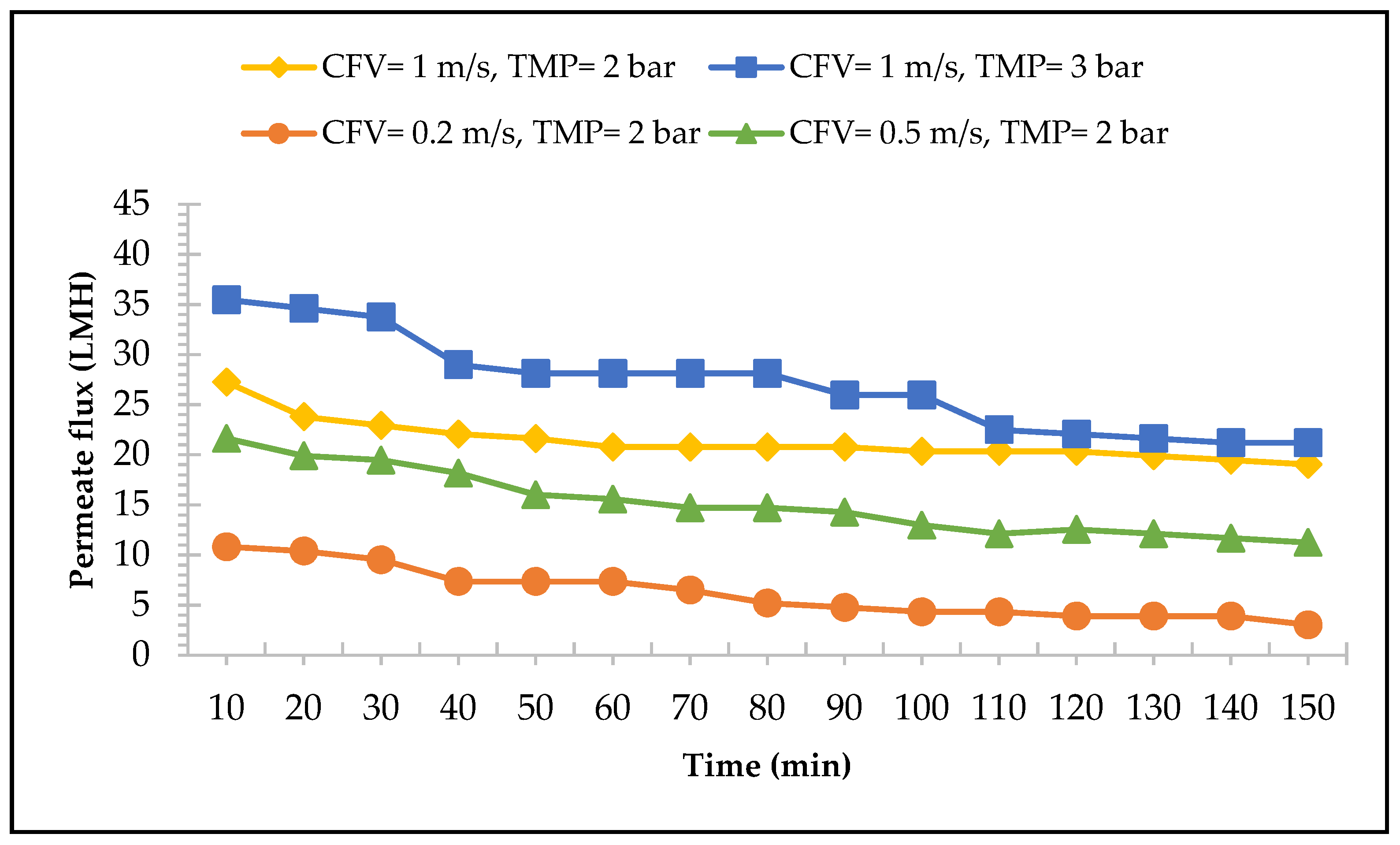A Novel Hybrid Membrane Process Coupled with Freeze Concentration for Phosphorus Recovery from Cheese Whey
Abstract
1. Introduction
2. Materials and Methods
2.1. Cheese Whey
2.2. Experimental Setup
2.3. Filtration Conditions
2.3.1. Membrane Precondition
2.3.2. Membrane Optimisation for a Single-Stage Filtration Operation
2.3.3. Membrane Optimisation after CW Pre-Treatment
2.4. Process Performances
2.5. Membrane Cleaning
2.6. Freeze Concentration Configuration and Operation
2.7. Two-Stage Coupled Technology of Membrane System and FC
2.8. Analytical Methods
2.9. Energy Consumption
3. Results and Discussion
3.1. One-Stage Filtration System
3.1.1. Clean Water Flux
3.1.2. MF Performance
3.1.3. UF Performance
3.2. Effects of Pre-Treatments on Permeate and P Recovery for MF and UF Membranes
3.3. Two-Stage Coupled Technology of Membrane System and FC for P Recovery
4. Conclusions
Supplementary Materials
Author Contributions
Funding
Institutional Review Board Statement
Informed Consent Statement
Data Availability Statement
Conflicts of Interest
References
- McIntosh, S.; Padilla, R.V.; Rose, T.; Rose, A.L.; Boukaka, E.; Erler, D. Crop fertilisation potential of phosphorus in hydrochars produced from sewage sludge. Sci. Total Environ. 2022, 817, 153023. [Google Scholar] [CrossRef] [PubMed]
- Karunanithi, R.; Szogi, A.; Bolan, N.S.; Naidu, R.; Ok, Y.S.; Krishnamurthy, S.; Seshadri, B. Phosphorus recovery from wastes. In Environmental Materials and Waste: Resource Recovery and Pollution Prevention; Academic Press; Elsevier Inc.: Cambridge, MA, USA, 2016; pp. 687–705. [Google Scholar] [CrossRef]
- Yan, T.; Ye, Y.; Ma, H.; Zhang, Y.; Guo, W.; Du, B.; Wei, Q.; Wei, D.; Ngo, H.H. A critical review on membrane hybrid system for nutrient recovery from wastewater. Chem. Eng. J. 2018, 348, 143–156. [Google Scholar] [CrossRef]
- Schröder, J.; Cordell, D.; Smit, A.L.; Rosemarin, A. Sustainable Use of Phosphorus: EU Tender ENV.B.1/ETU/2009/0025. No 357; Plant Research International, Wageningen UR: Wageningen, The Netherlands, 2009. [Google Scholar]
- Amann, A.; Zoboli, O.; Krampe, J.; Rechberger, H.; Zessner, M.; Egle, L. Environmental impacts of phosphorus recovery from municipal wastewater. Resour. Conserv. Recycl. 2018, 130, 127–139. [Google Scholar] [CrossRef]
- Hakkou, R.; Benzaazoua, M.; Bussière, B. Valorization of Phosphate Waste Rocks and Sludge from the Moroccan Phosphate Mines: Challenges and Perspectives. Procedia Eng. 2016, 138, 110–118. [Google Scholar] [CrossRef]
- Li, X.; Shen, S.; Xu, Y.; Guo, T.; Dai, H.; Lu, X. Application of membrane separation processes in phosphorus recovery: A review. Sci. Total. Environ. 2021, 767, 144346. [Google Scholar] [CrossRef]
- Cordell, D.; Drangert, J.-O.; White, S. The story of phosphorus: Global food security and food for thought. Glob. Environ. Chang. 2009, 19, 292–305. [Google Scholar] [CrossRef]
- European Commission. 2017 List of Critical Raw Materials for the EU. Off. J. Eur. Union 2017, 490, 8. Available online: https://eur-lex.europa.eu/legal-content/EN/TXT/PDF/?uri=CELEX:52017DC0490&from=EN (accessed on 22 October 2022).
- Slavov, A.K. General characteristics and treatment possibilities of dairy wastewater—A review. Food Technol. Biotechnol. 2017, 55, 14–28. [Google Scholar] [CrossRef]
- Lei, Y.; Zhan, Z.; Saakes, M.; van der Weijden, R.D.; Buisman, C.J.N. Electrochemical Recovery of Phosphorus from Acidic Cheese Wastewater: Feasibility, Quality of Products, and Comparison with Chemical Precipitation. ACS ES&T Water 2021, 1, 1002–1013. [Google Scholar] [CrossRef]
- European Commission; Eurostat. Agriculture, Forestry and Fishery Statistics: 2018 Edition; Publications Office: Luxembourg, 2019. [Google Scholar]
- Demirel, B.; Yenigun, O.; Onay, T.T. Anaerobic treatment of dairy wastewaters: A review. Process. Biochem. 2005, 40, 2583–2595. [Google Scholar] [CrossRef]
- Venetsaneas, N.; Antonopoulou, G.; Stamatelatou, K.; Kornaros, M.; Lyberatos, G. Using cheese whey for hydrogen and methane generation in a two-stage continuous process with alternative pH controlling approaches. Bioresour. Technol. 2009, 100, 3713–3717. [Google Scholar] [CrossRef] [PubMed]
- Janczukowicz, W.; Zieliński, M.; Debowski, M. Biodegradability evaluation of dairy effluents originated in selected sections of dairy production. Bioresour. Technol. 2008, 99, 4199–4205. [Google Scholar] [CrossRef]
- Britz, J.T.; van Sch alwyk, C.; Hung, H.T. Treatment of dairy processing wastewaters. In Waste Treatment in the Food Processing Industry; Wang, L.K., Hung, Y.-T., Lo, H.H., Yapijakis, C., Eds.; CRC Press: Boca Raton, FL, USA, 2006; pp. 1–25. [Google Scholar]
- Carrillo, V.; Fuentes, B.; Gómez, G.; Vidal, G. Characterization and recovery of phosphorus from wastewater by combined technologies. Rev. Environ. Sci. Bio/Technol. 2020, 19, 389–418. [Google Scholar] [CrossRef]
- Wang, Y.; Serventi, L. Sustainability of dairy and soy processing: A review on wastewater recycling. J. Clean. Prod. 2019, 237, 117821. [Google Scholar] [CrossRef]
- Sánchez, J.; Hernández, E.; Auleda, J.; Raventós, M. Freeze concentration of whey in a falling-film based pilot plant: Process and characterization. J. Food Eng. 2011, 103, 147–155. [Google Scholar] [CrossRef]
- Bacelo, H.; Pintor, A.M.; Santos, S.C.; Boaventura, R.A.; Botelho, C.M. Performance and prospects of different adsorbents for phosphorus uptake and recovery from water. Chem. Eng. J. 2020, 381, 122566. [Google Scholar] [CrossRef]
- Rivas, J.; Prazeres, A.R.; Carvalho, F. Aerobic Biodegradation of Precoagulated Cheese Whey Wastewater. J. Agric. Food Chem. 2011, 59, 2511–2517. [Google Scholar] [CrossRef]
- Carvalho, F.; Prazeres, A.R.; Rivas, J. Cheese whey wastewater: Characterization and treatment. Sci. Total Environ. 2013, 445–446, 385–396. [Google Scholar] [CrossRef]
- Li, K.; Liu, Q.; Fang, F.; Luo, R.; Lu, Q.; Zhou, W.; Huo, S.; Cheng, P.; Liu, J.; Addy, M.; et al. Microalgae-based wastewater treatment for nutrients recovery: A review. Bioresour. Technol. 2019, 291, 121934. [Google Scholar] [CrossRef]
- Prazeres, A.R.; Fernandes, F.; Luz, S.; Jerónimo, E. Simple processes for contamination removal in cheesemaking wastewater: CaCO3, Mg(OH)2, FeSO4 and FeCl3. J. Environ. Chem. Eng. 2020, 8, 104034. [Google Scholar] [CrossRef]
- Numviyimana, C.; Warchoł, J.; Ligas, B.; Chojnacka, K. Nutrients Recovery from Dairy Wastewater by Struvite Precipitation Combined with Ammonium Sorption on Clinoptilolite. Materials 2021, 14, 5822. [Google Scholar] [CrossRef] [PubMed]
- Bortoluzzi, A.C.; Faitão, J.A.; Di Luccio, M.; Dallago, R.M.; Steffens, J.; Zabot, G.L.; Tres, M.V. Dairy wastewater treatment using integrated membrane systems. J. Environ. Chem. Eng. 2017, 5, 4819–4827. [Google Scholar] [CrossRef]
- Castro-Muñoz, R.; Yáñez-Fernández, J.; Fíla, V. Phenolic compounds recovered from agro-food by-products using membrane technologies: An overview. Food Chem. 2016, 213, 753–762. [Google Scholar] [CrossRef] [PubMed]
- Reig, M.; Vecino, X.; Cortina, J.L. Use of Membrane Technologies in Dairy Industry: An Overview. Foods 2021, 10, 2768. [Google Scholar] [CrossRef]
- Lipnizki, F. Cross-Flow Membrane Applications in the Food Industry. Membr. Technol. 2010, 3, 1–24. [Google Scholar] [CrossRef]
- Jaspe, J.; Hagen, S.J. Do Protein Molecules Unfold in a Simple Shear Flow? Biophys. J. 2006, 91, 3415–3424. [Google Scholar] [CrossRef]
- Konrad, G.; Kleinschmidt, T.; Faber, W. Ultrafiltration flux of acid whey obtained by lactic acid fermentation. Int. Dairy J. 2012, 22, 73–77. [Google Scholar] [CrossRef]
- Steinhauer, T.; Marx, M.; Bogendörfer, K.; Kulozik, U. Membrane fouling during ultra- and microfiltration of whey and whey proteins at different environmental conditions: The role of aggregated whey proteins as fouling initiators. J. Membr. Sci. 2015, 489, 20–27. [Google Scholar] [CrossRef]
- Grandison, A.S.; Youravong, W.; Lewis, M.J. Hydrodynamic factors affecting flux and fouling during ultrafiltration of skimmed milk. Lait 2000, 80, 165–174. [Google Scholar] [CrossRef]
- De Wit, J.N. Spontaneous precipitation of fatty components and bacteria from whey. Milchwissenschaft 2009, 64, 409–412. [Google Scholar]
- Rao, H.R. Mechanisms of flux decline during ultrafiltration of dairy products and influence of pH on flux rates of whey and buttermilk. Desalination 2002, 144, 319–324. [Google Scholar] [CrossRef]
- Hamid, F.H.; Rahim, N.A.; Johari, A.; Ngadi, N.; Zakaria, Z.Y.; Jusoh, M. Desalination of seawater through progressive freeze concentration using a coil crystallizer. Water Supply 2015, 15, 625–631. [Google Scholar] [CrossRef]
- Miyawaki, O.; Liu, L.; Shirai, Y.; Sakashita, S.; Kagitani, K. Tubular ice system for scale-up of progressive freeze-concentration. J. Food Eng. 2005, 69, 107–113. [Google Scholar] [CrossRef]
- Auleda, J.; Raventós, M.; Hernández, E. Calculation method for designing a multi-plate freeze-concentrator for concentration of fruit juices. J. Food Eng. 2011, 107, 27–35. [Google Scholar] [CrossRef]
- Sánchez, J.; Ruiz, Y.; Auleda, J.; Hernández, E.; Raventós, M. Review. Freeze Concentration in the Fruit Juices Industry. Food Sci. Technol. Int. 2009, 15, 303–315. [Google Scholar] [CrossRef]
- Dadrasnia, A.; Muñoz, I.D.B.; Yáñez, E.H.; Lamkaddam, I.U.; Mora, M.; Ponsá, S.; Ahmed, M.; Argelaguet, L.L.; Williams, P.M.; Oatley-Radcliffe, D.L. Sustainable nutrient recovery from animal manure: A review of current best practice technology and the potential for freeze concentration. J. Clean. Prod. 2021, 315, 128106. [Google Scholar] [CrossRef]
- Jusoh, M.; Youns, R.M.; Hassan, M.A.A. Effect of Flowrate and Coolant Temperature on the Efficiency of Progressive Freeze Concentration on Simulated Wastewater. Int. J. Chem. Mol. Eng. 2008, 11, 308–311. [Google Scholar] [CrossRef]
- Samsuri, S.; Amran, N.A.; Jusoh, M. Modelling of heat transfer for progressive freeze concentration process by spiral finned crystallizer. Chin. J. Chem. Eng. 2017, 26, 970–975. [Google Scholar] [CrossRef]
- Hamid, F.H.; Jami, S.N. Progressive Freeze Concentration for Wastewater Treatment from Food Industry. Key Eng. Mater. 2019, 797, 55–64. [Google Scholar] [CrossRef]
- Canella, M.H.M.; Barros, E.L.D.S.; Camelo-Silva, C.; Verruck, S.; Daguer, H.; Molognoni, L.; Prudencio, E.S. Performance of Skim Goat Milk Mineral Content Subjected to the Block Freeze Concentration Process. Asian J. Adv. Agric. Res. 2019, 9, 1–9. [Google Scholar] [CrossRef]
- Gao, W. Freeze concentration for membrane concentrate treatment and volume reduction. Desalination Water Treat. 2013, 51, 1200–1204. [Google Scholar] [CrossRef]
- Canella, M.H.M.; Muñoz, I.D.B.; Pinto, S.S.; De Liz, G.R.; Müller, C.M.O.; Amboni, R.D.D.M.C.; Prudêncio, E.S. Use of Concentrated Whey by Freeze Concentration Process to Obtain a Symbiotic Fermented Lactic Beverage. Adv. J. Food Sci. Technol. 2018, 14, 56–68. [Google Scholar] [CrossRef]
- Hernandez, E.; Belen, F.; Raventos, M. Management of cheese whey by film freeze concentration. Environ. Eng. Manag. J. 2018, 17, 1373–1383. [Google Scholar] [CrossRef]
- Lu, H.; Wang, J.; Wang, T.; Wang, N.; Bao, Y.; Hao, H. Crystallization techniques in wastewater treatment: An overview of applications. Chemosphere 2017, 173, 474–484. [Google Scholar] [CrossRef] [PubMed]
- Lamkaddam, I.U.; Vega, E.; Colón, J.; Ponsá, S.; Llenas, L.; Mora, M. Progressive freeze concentration of cheese whey for protein and lactose recovery. Int. Dairy J. 2023, 139, 105572. [Google Scholar] [CrossRef]
- Jawor, A.; Hoek, E.M. Effects of feed water temperature on inorganic fouling of brackish water RO membranes. Desalination 2009, 235, 44–57. [Google Scholar] [CrossRef]
- Ramos, F.; Delgado, J.; Bautista, E.; Morales, A.; Duque, C. Changes in volatiles with the application of progressive freeze-concentration to Andes berry (Rubus glaucus Benth). J. Food Eng. 2005, 69, 291–297. [Google Scholar] [CrossRef]
- APHA/AWWA/WEF. Standard Methods for the Examination of Water and Wastewater, 23rd ed.; American Public Health Association: Washington, DC, USA, 2017; ISBN 9780875532356. [Google Scholar]
- Atra, R.; Vatai, G.; Bekassy-Molnar, E.; Balint, A. Investigation of ultra- and nanofiltration for utilization of whey protein and lactose. J. Food Eng. 2005, 67, 325–332. [Google Scholar] [CrossRef]
- Leu, M.; Marciniak, A.; Chamberland, J.; Pouliot, Y.; Bazinet, L.; Doyen, A. Effect of skim milk treated with high hydrostatic pressure on permeate flux and fouling during ultrafiltration. J. Dairy Sci. 2017, 100, 7071–7082. [Google Scholar] [CrossRef]
- Steinhauer, T.; Schwing, J.; Krauß, S.; Kulozik, U. Enhancement of ultrafiltration-performance and improvement of hygienic quality during the production of whey concentrates. Int. Dairy J. 2015, 45, 8–14. [Google Scholar] [CrossRef]
- Giacobbo, A.; Oliveira, M.; Duarte, E.D.A.; Mira, H.; Bernardes, A.M.; De Pinho, M.N. Ultrafiltration Based Process for the Recovery of Polysaccharides and Polyphenols from Winery Effluents. Sep. Sci. Technol. 2013, 48, 438–444. [Google Scholar] [CrossRef]
- Yeh, H.M. Decline of permeate flux for ultrafiltration along membrane tubes. Desalination 2002, 145, 153–157. [Google Scholar] [CrossRef]
- Sofuwani, Z.A.N.; Aslina, H.S.; Mazlina, M.K.S. Separation of lactose from raw goat’s milk by cross-flow hollow fiber ultrafiltration membrane. Int. Food Res. J. 2018, 23, S209–S219. [Google Scholar]
- Cassano, A.; Conidi, C.; Ruby-Figueroa, R.; Castro-Muñoz, R. Nanofiltration and Tight Ultrafiltration Membranes for the Recovery of Polyphenols from Agro-Food By-Products. Int. J. Mol. Sci. 2018, 19, 351. [Google Scholar] [CrossRef]
- Mourouzidis-Mourouzis, S.; Karabelas, A. Whey protein fouling of microfiltration ceramic membranes—Pressure effects. J. Membr. Sci. 2006, 282, 124–132. [Google Scholar] [CrossRef]
- Tsuge, H.; Tanaka, Y.; Hisamatsu, N. Fouling of Cheese Whey during Reverse Osmosis and Precipitation of Calcium Phosphate. J. Petrol. 2020, 369, 1689–1699. [Google Scholar] [CrossRef]
- Uragami, T. Science and Technology of Separation Membranes; John Wiley & Sons: Hoboken, NJ, USA, 2017. [Google Scholar]
- Pires, A.F.; Marnotes, N.G.; Rubio, O.D.; Garcia, A.C.; Pereira, C.D. Dairy By-Products: A Review on the Valorization of Whey and Second Cheese Whey. Foods 2021, 10, 1067. [Google Scholar] [CrossRef]
- Onwulata, C.; Huht, P. Whey Processing, Functionality and Health Benefits; John Wiley & Sons, Ltd: Hoboken, NJ, USA, 2009; Volume 8. [Google Scholar]
- Henriques, M.H.F.; Gomes, D.M.G.S.; Borges, A.R.; Pereira, C.J.D. Liquid whey protein concentrates as primary raw material for acid dairy gels. Food Sci. Technol. 2020, 40, 361–369. [Google Scholar] [CrossRef]
- Hinrichs, J. Incorporation of whey proteins in cheese. Int. Dairy J. 2001, 11, 495–503. [Google Scholar] [CrossRef]
- Lei, Y.; Remmers, J.C.; Saakes, M.; Van Der Weijden, R.D.; Buisman, C.J.N. Influence of Cell Configuration and Long-Term Operation on Electrochemical Phosphorus Recovery from Domestic Wastewater. ACS Sustain. Chem. Eng. 2019, 7, 7362–7368. [Google Scholar] [CrossRef]
- Kok, D.-J.D.; Pande, S.; van Lier, J.B.; Ortigara, A.R.C.; Savenije, H.; Uhlenbrook, S. Global phosphorus recovery from wastewater for agricultural reuse. Hydrol. Earth Syst. Sci. 2018, 22, 5781–5799. [Google Scholar] [CrossRef]






| Parameter | Value | Unit |
|---|---|---|
| Total solids (TS) | 69 ± 1 | g/kg |
| Volatile solids (VS) | 59 ± 1 | g/kg |
| Total Kjeldahl nitrogen (TKN) | 0.80 ± 0.03 | g/L |
| N-ammonium (N-NH4+) | 0.37 ± 0.07 | g/L |
| Total phosphorus (TP) | 0.39 ± 0.03 | g/L |
| Chemical oxygen demand (COD) | 87 ± 1 | g/L |
| Conductivity | 8.36 ± 0.05 | mS/cm |
| pH | 4.46 ± 0.02 | - |
| Membrane Module | CFV (m/s) | TMP (bar) |
|---|---|---|
| MF 0.2 µm | 0.2 | 0.8 |
| 0.5 | 0.8 | |
| UF 200 kDa | 0.2 | 2 |
| 0.5 | 2 | |
| 1.0 | 2 | |
| 1.0 | 3 |
| Membrane | Clean Water Flux (L/h·m2) | Water Hydraulic Permeability (L/h·m2·bar) | Pressure (bar) | CFV (m/s) | Cleaning Efficiency (%) |
|---|---|---|---|---|---|
| MF 0.2 µm | 281 ± 2 | 351.5 ± 0.2 | 0.8 | 0.2 and 0.5 | 99 |
| UF 200 kDa | 230 ± 1 | 76.4 ± 0.5 | 3 | 0.2, 0.5, and 1 | 99 |
| UF 200 kDa | 230 ± 1 | 115.2 ± 0.1 | 2 | 0.2, 0.5, and 1 | 99 |
Disclaimer/Publisher’s Note: The statements, opinions and data contained in all publications are solely those of the individual author(s) and contributor(s) and not of MDPI and/or the editor(s). MDPI and/or the editor(s) disclaim responsibility for any injury to people or property resulting from any ideas, methods, instructions or products referred to in the content. |
© 2023 by the authors. Licensee MDPI, Basel, Switzerland. This article is an open access article distributed under the terms and conditions of the Creative Commons Attribution (CC BY) license (https://creativecommons.org/licenses/by/4.0/).
Share and Cite
Hidayat, I.; Paredes, L.; Binder, P.M.; Guerra-Gorostegi, N.; Mora, M.; Ponsá, S.; Oatley-Radcliffe, D.L.; Llenas, L. A Novel Hybrid Membrane Process Coupled with Freeze Concentration for Phosphorus Recovery from Cheese Whey. Membranes 2023, 13, 450. https://doi.org/10.3390/membranes13040450
Hidayat I, Paredes L, Binder PM, Guerra-Gorostegi N, Mora M, Ponsá S, Oatley-Radcliffe DL, Llenas L. A Novel Hybrid Membrane Process Coupled with Freeze Concentration for Phosphorus Recovery from Cheese Whey. Membranes. 2023; 13(4):450. https://doi.org/10.3390/membranes13040450
Chicago/Turabian StyleHidayat, Ipan, Lidia Paredes, Pablo M. Binder, Nagore Guerra-Gorostegi, Mabel Mora, Sergio Ponsá, Darren L. Oatley-Radcliffe, and Laia Llenas. 2023. "A Novel Hybrid Membrane Process Coupled with Freeze Concentration for Phosphorus Recovery from Cheese Whey" Membranes 13, no. 4: 450. https://doi.org/10.3390/membranes13040450
APA StyleHidayat, I., Paredes, L., Binder, P. M., Guerra-Gorostegi, N., Mora, M., Ponsá, S., Oatley-Radcliffe, D. L., & Llenas, L. (2023). A Novel Hybrid Membrane Process Coupled with Freeze Concentration for Phosphorus Recovery from Cheese Whey. Membranes, 13(4), 450. https://doi.org/10.3390/membranes13040450










